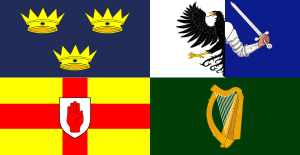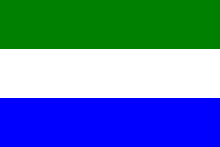Cross-border flag for Ireland
There is no cross-border flag universally accepted as representing both jurisdictions in Ireland. This can be a problem in contexts where a body organised on an all-island basis needs to be represented by a flag in an international context. The island is politically divided into the Republic of Ireland (a sovereign state) and Northern Ireland (a constituent country of the United Kingdom), but all-island organisations are common. Examples include the Roman Catholic Church in Ireland, the Presbyterian Church in Ireland and the Church of Ireland, the Gaelic Athletic Association, and the Irish Rugby Football Union.
Saint Patrick's Saltire
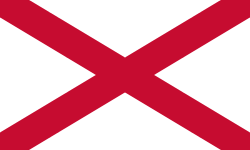
The Saint Patrick's Saltire was incorporated into the Union Flag in 1801 by way of the Act of Union 1800 to represent Ireland within the new United Kingdom of Great Britain and Ireland. Today, those who regard the tricolour as specific to the Republic of Ireland, or excluding unionists, may advocate it as a neutral symbol of the whole island.
The Church of Ireland orders that, apart from the flag of the Anglican Communion, only this saltire may be flown on its church grounds—as opposed to the tricolour, the Union Flag or the former flag of Northern Ireland. This follows the practice of other Anglican churches in England, Scotland, and Wales, which fly the flags of their respective patron saints instead of the Union Flag.[1]
The saltire is also flown by St. Patrick's College, Maynooth, on graduation days, and so it can be argued that St. Patrick's Saltire is used by the main Protestant church on the island and the Roman Catholic Church.
Modified versions have been used formerly by the Irish Rugby Football Union, and currently by the Royal College of Surgeons in Ireland and the Commissioners of Irish Lights.[2]
Irish tricolour

The tricolour of green, white and orange, the official flag of the state of Ireland, is considered by Irish nationalists, to represent the entire island as well. Gerry Adams said in Dáil Éireann in 2011:[3]
Above this Chamber flies the flag of this nation — all Thirty-Two Counties — the flag of green, white and orange.
However, this symbolism is rejected by Ulster unionists, as illustrated by an exchange in the House of Commons of Northern Ireland in 1951:[4]
- James McSparran: The tricolour is admitted by all nations within the comity of nations to be the national flag of Ireland.
- Honorable members: No.
- McSparran: We are having interruptions already. It is the national flag of the Irish Republic.
- William May: That is better.
The Gaelic Athletic Association (GAA) flies this flag at matches regardless of whether either or both teams are from Northern Ireland. It is also used for the Ireland international rules football team, selected by the GAA on an all-island basis.
The Golfing Union of Ireland covers the whole island and competes under the tricolour in international events such as the World Cup, Alfred Dunhill Cup and the Eisenhower Trophy.[5]
Four Provinces flag
The four provinces flag is a quartering of the arms of the four provinces of Ireland. The order of the provinces varies.
Erne flag
This flag was initially used on the Shannon–Erne Waterway, which is bisected by the border. Rather than flying a national flag, boats fly this green, white and blue flag.[6] It is endorsed by the Inland Waterways Association of Ireland, an all-island organisation.[7]
Harp flags
.svg.png)
The harp (or cláirseach) has long been a symbol of Ireland. It first featured on Irish coins in the reign of Henry VIII around 1534.[8] During the seventeenth and eighteenth century, the harp became adorned with progressively more decoration, ultimately becoming a "winged maiden".[9][10] In the nineteenth century, the Maid of Erin, a personification of Ireland, was a woman holding a more realistic harp than the "winged maiden". This style of harp was then also used in Irish flags. The harp on the modern coat of arms of the Republic of Ireland is modelled on the "Brian Boru" harp in the library of Trinity College, Dublin, as it appeared after an 1840s restoration.
Blue harp flag
The lower left quadrant of the Royal Standard of the United Kingdom has featured a harp on a blue field, representing Ireland since 1603.[8] The current version, designed in 1953, uses a winged-maiden harp and consists of a golden cláirseach with silver strings on a blue background. The shade of blue in the field was known as Saint Patrick's Blue when used in 1783 for the regalia of the Order of Saint Patrick.[11]
Green harp flag

The change from blue to green is associated with the United Irishmen, an Irish nationalist movement associated with both Catholic and Protestant Irish - its leader Wolfe Tone was Protestant; green was a colour of rebellion in the eighteenth century.[12] This was a common flag used to represent Ireland during the nineteenth and early twentieth centuries. It consisted of a gold cláirseach on a green background. It was associated with moderate nationalism at a time when the tricolour was confined to more radical movements. It is the same as the modern Flag of Leinster.
Sporting flags
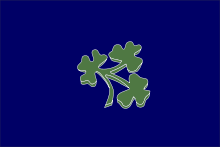
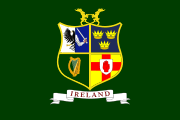
Several all-island sporting organisations send representative teams to compete internationally. In some cases, a flag unique to that organisation is used in lieu of a national flag. Typically such flags include one of the traditional symbols of Ireland.
The Ireland cricket team, which competes in One Day International tournaments, uses a flag depicting shamrocks.
The Ireland national field hockey team uses a bespoke flag with a shield quartered with the symbols of the four provinces.
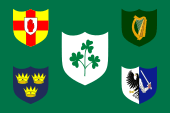
The Ireland rugby team's flag is a green flag containing the shields of the four provinces and the Irish Rugby Football Union's logo. At matches outside Ireland, this is the only flag displayed. At matches in Northern Ireland (typically at Ravenhill) the Flag of Ulster is also displayed. This is the flag of the nine-county province (including the three Ulster counties in the Republic of Ireland), similar to but distinct from the Ulster Banner, the former flag of the Northern Irish government. At matches in the Republic of Ireland (typically at Lansdowne Road), the Irish tricolour is flown along with the preceding two.
Eddie Irvine, a Formula One driver from Conlig in Northern Ireland, asked for a white flag with a shamrock to be used if he secured a podium finish.[13] There had been controversy when an Irish tricolour had been used incorrectly for him in 1997.[13] The FIA insisted the Union Flag be used in conformance with its regulations.[13]
See also
- "Ireland's Call", used as a national anthem for the rugby union team
- Northern Ireland flags issue
References
- ↑ Church of Ireland (April 1999). "Church Of Ireland General Synod Sub Committee On Sectarianism Report".: Resolution One: The General Synod of the Church of Ireland recognises that from time to time confusion and controversy have attended the flying of flags on church buildings or within the grounds of church buildings. This Synod therefore resolves that the only flags specifically authorised to be flown on church buildings or within the church grounds of the Church of Ireland are the cross of St Patrick or, alternatively, the flag of the Anglican Communion bearing the emblem of the Compassrose. Such flags are authorised to be flown only on Holy Days and during the Octaves of Christmas, Easter, the Ascension of Our Lord and Pentecost, and on any other such day as may be recognised locally as the Dedication Day of the particular church building. Any other flag flown at any other time is not specifically authorised by this Church.
- ↑ Dillon, Jim (1995). "The Evolution of Maritime Uniform". Beam. Commissioners of Irish Lights. 24. Archived from the original on 13 October 2013. Retrieved 27 April 2011.
In the Lighthouse Service the cap badge originally was a St George's Cross surrounded by a wreath of laurel leaves but from 1970 the St Patrick's Cross has been used.
- ↑ Dáil debates Vol.728 No.1 p.8 c.52
- ↑ http://stormontpapers.ahds.ac.uk/stormontpapers/pageview.html?volumeno=35&pageno=2093&searchTerm=tricolour#bak-35-2073
|chapter-url=missing title (help). Parliamentary Debates (Hansard). 35. Commons N.I. 21 August 1951. col. 2073. - ↑ MacGinty, Karl (November 4, 2008). "McDowell and McGinley fly the flag for Ireland". Irish Independent. Retrieved 2008-11-07.
- ↑ "Lough Erne Flag & IWAI Pennants". Lough Erne Flag. IWAI. Archived from the original on 19 November 2007. Retrieved 12 August 2010.
- ↑ "Erne Flag". Inland Waterways Association of Ireland. Retrieved 12 August 2010.
- 1 2 Morris, Ewan (2005). Our own devices: National symbols and polititcal conflict in Twentieth-Century Ireland. Irish Academic Press. p. 12. ISBN 0-7165-2663-8.
- ↑ Burgers, Andries (21 May 2006). "Ireland: Green Flag". Flags of the World. Archived from the original on 30 December 2005. Retrieved 1 September 2013.
- ↑ Boydell, Barra (1996). "The Iconography of the Irish Harp as a National Symbol". In Patrick F. Devine & Harry White. Irish Musical Studies. 5. Four Courts Press. ISBN 1-85182-261-5.
- ↑ Cullen, Fintan (1995). "Visual Politics in 1780s Ireland: The Roles of History Painting". Oxford Art Journal. Oxford University Press. 18 (1): 65. JSTOR 1360595.
- ↑ Naval Service - Flags and Pennants
- 1 2 3 "Sporting political gestures". The Irish Times. 23 June 2009. Retrieved 2009-06-23.
